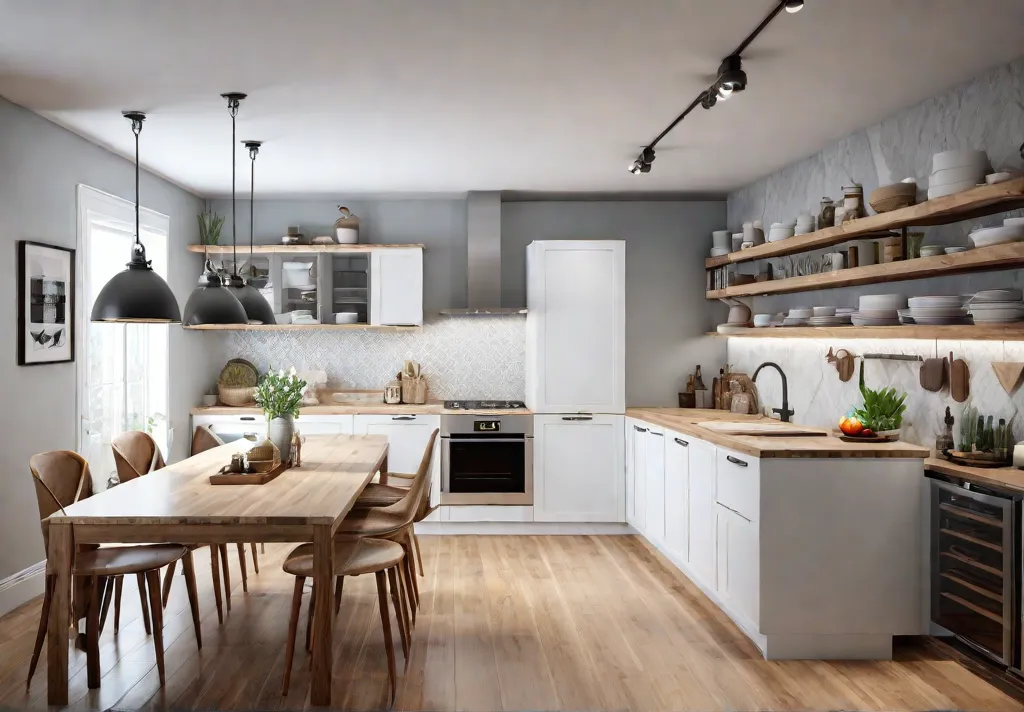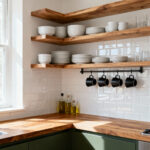Hey there, fellow small kitchen warriors! Craig here, and boy do I have some game-changing tips for you today. If you’ve ever felt like your kitchen was closing in on you faster than Atlanta traffic at rush hour, then buckle up, because we’re about to turn that cramped cookspace into a cozy culinary haven.
Now, I know what you’re thinking – “Craig, my kitchen’s so tiny, I can barely fit a cookie sheet in there!” But trust me, after years of transforming pint-sized kitchens across Atlanta, I’ve learned a thing or two about making the most of every square inch. From color magic to clever storage hacks, we’re going to explore nine decor ideas that’ll have your small kitchen feeling bigger than a Georgia peach orchard. So grab a sweet tea and let’s dive in!
Color Me Spacious: The Power of Light
Trust me, I’ve seen some dark, cramped kitchens transform into airy, inviting spaces with just a few coats of paint. It’s like watching a caterpillar turn into a butterfly but with less waiting and more immediate gratification!
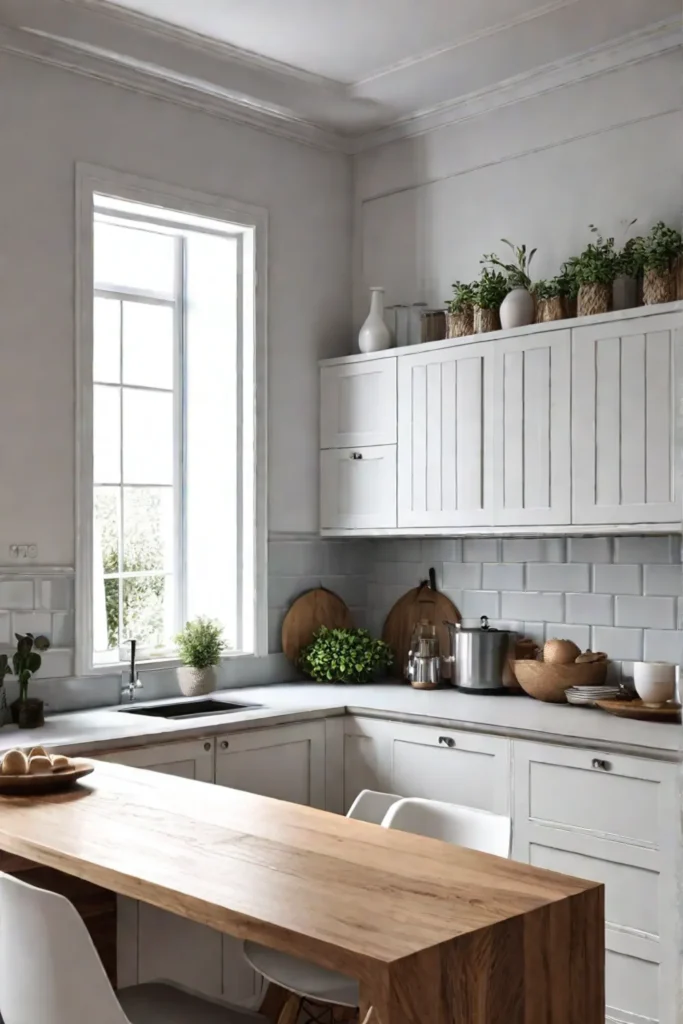
The Science of Light and Color
Now, I’m no physicist, but I’ve learned a thing or two about how light and color play together in our homes. Here’s the scoop: light colors are like that friendly neighbor who always returns your borrowed tools – they reflect light back into the room. Dark colors, on the other hand, are more like that grumpy old man who keeps your frisbee when it lands in his yard – they absorb light and keep it to themselves.
But here’s where it gets cool: our eyes perceive lighter colors as receding and darker colors as advancing. It’s like an optical illusion right there on your kitchen walls! This little trick of the eye can make your small kitchen feel more spacious without knocking down a single wall.
Best Light Color Palettes for Small Kitchens
So, what colors should you be reaching for at the paint store? Here are my top picks:
- White: The classic choice for a reason. It’s like a blank canvas for your culinary creativity.
- Cream: Adds a touch of warmth without sacrificing that light-reflecting goodness.
- Pastels: Soft blues, greens, or yellows can add a hint of personality while keeping things bright.
- Light grays: For those who want a more modern, sophisticated look.
But don’t just stop at the walls! Paint those cabinets, and yes, even the ceiling. It’s like giving your kitchen a facelift and a skylight all at once.
Now, I know what you’re thinking – “Craig, won’t all that light color be boring?” Not if you do it right! Here’s a pro tip: consider using a high-gloss paint finish. It’ll reflect even more light and add a touch of glamour to your space. It’s like adding a disco ball to your kitchen, minus the 70s vibes.

Color Palettes for Different Kitchen Styles
Different kitchen styles call for different approaches. Here’s a quick guide:
- Modern: Go for crisp whites paired with light grays for a sleek, contemporary feel.
- Farmhouse: Soft creams and light sage greens can create a cozy, rustic atmosphere.
- Coastal: Light blues and sandy beiges will have you feeling beachy keen in no time.
- Scandinavian: Embrace the “hygge” with warm whites and light wood tones.
Remember, the key is to keep it light but don’t be afraid to add pops of color through accessories or a bold backsplash. It’s all about balance, like a perfectly plated meal.
I once helped a friend transform her tiny, dark galley kitchen into a bright, inviting space. We painted the walls a soft cream, the cabinets a glossy white, and added a pale blue ceiling for a touch of whimsy. The before-and-after photos looked like they were from different houses! She swears her morning coffee tastes better now – I think it’s just the power of good lighting.
Light colors are your secret weapon in the battle against small kitchen blues. They open up the space, reflect more light, and create an airy, inviting atmosphere that’ll make you want to whip up a gourmet meal – or at least order takeout in style.
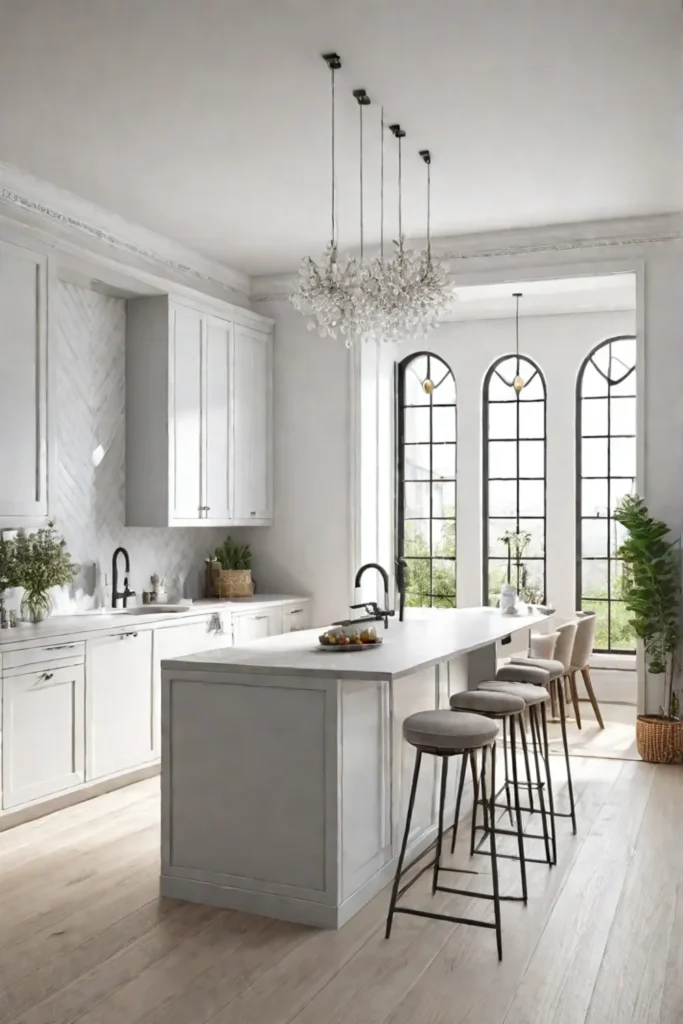
Speaking of style, want to know another trick for making your kitchen feel twice as big? It’s time to talk about mirrors, baby! In our next section, “Mirror, Mirror on the Wall: Expanding Your Kitchen’s Potential,” we’ll explore how a well-placed mirror can work wonders in your small kitchen. Get ready to see double – in the best way possible!
Mirror, Mirror on the Wall: Expanding Your Kitchen’s Potential
I have tackled countless tiny spaces in Atlanta’s charming older homes, and I’ve learned a thing or two about creating the illusion of space. And let me tell you, mirrors are your secret weapon!
The Magic of Mirrors in the Kitchen
Mirrors aren’t just for checking if you’ve got flour on your nose while baking. They’re like magic wands for your kitchen, reflecting light and creating depth where there seemingly isn’t any. It’s like giving your kitchen a superpower – the ability to appear larger than it is!
Types of Mirrors for the Kitchen
- Full-length mirrors: Perfect for creating a dramatic effect and doubling the visual space.
- Mirrored backsplashes: A trendy option that adds a touch of glamour while making your kitchen feel more open.
- Mirrored cabinet doors: These bad boys reflect light and create an airy feel without sacrificing storage.
- Decorative mirror tiles: Great for adding personality and dimension to small areas.

Creative Mirror Placement Ideas
Now, let’s talk strategy. Where you put your mirrors can make or break the illusion. Here are some of my favorite tricks:
- Hang a large mirror above the sink or stove. It’s like adding a window where there isn’t one!
- Use a mirrored backsplash behind the cooktop. Not only does it look sleek, but it also reflects your beautiful cookware.
- Install mirrored cabinet doors on upper cabinets. This works wonders for brightening up dark corners.
- Place a mirror opposite a window to bounce natural light around the room.
Safety First: Mirrors in the Kitchen
Now, I know what you’re thinking – “Craig, isn’t it dangerous to have mirrors in the kitchen?” Well, you’re not wrong to be cautious. Here are a few safety tips:
- Use shatter-resistant mirrors or apply a safety film to regular mirrors.
- Avoid placing mirrors directly behind the stove or in areas prone to splashes.
- Ensure all mirrors are securely mounted to prevent accidents.
The Latest Trends in Kitchen Mirror Design
The world of kitchen design is always evolving, and mirrors are no exception. Here are some trends I’m loving right now:
- Antique mirror tiles: These add a vintage charm and depth to your space.
- Geometric shapes: Hexagons, circles, and asymmetrical designs are making a splash.
- Smoked glass mirrors: Perfect for adding a moody, sophisticated vibe.
- Backlit mirrors: These not only expand space but also provide ambient lighting.
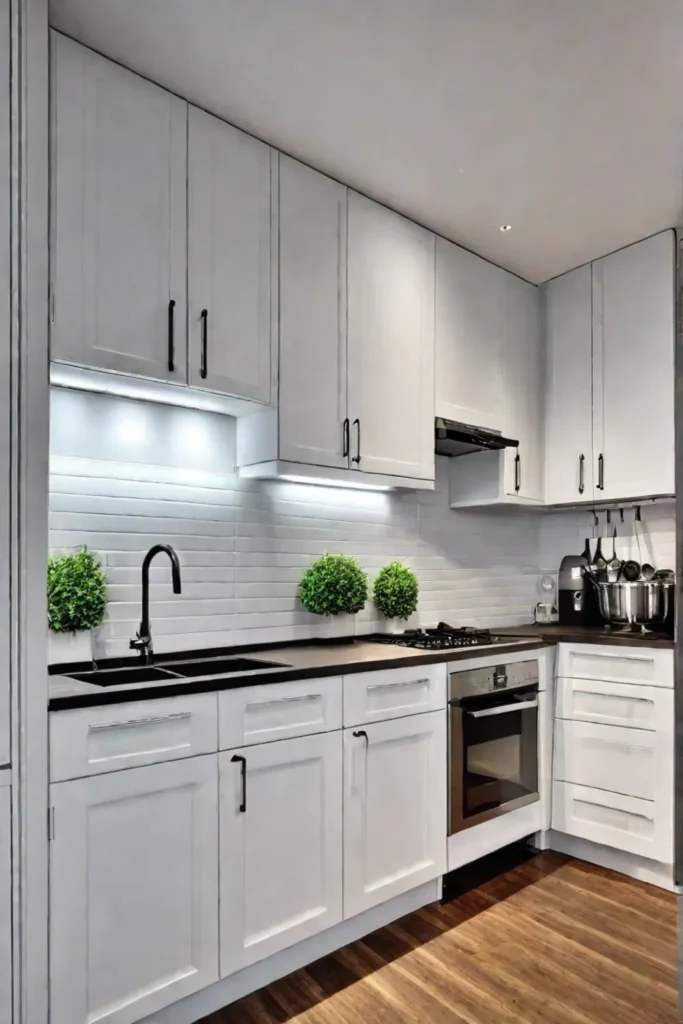
Practical Tips for Mirror Magic
- Clean your mirrors regularly – smudges and splashes can ruin the effect.
- Experiment with different frame styles to complement your kitchen decor.
- Use mirrors to highlight your favorite kitchen features or artwork.
- Don’t go overboard – a few well-placed mirrors can work wonders, but too many can feel like a funhouse!
Remember, folks, mirrors have been used for centuries to enhance spaces. From the grand halls of Versailles to your cozy kitchen nook, they’re a timeless trick for creating the illusion of space and light.
As we wrap up our mirror magic, let’s turn our attention to another space-maximizing strategy. In our next section, “Open Shelving: Embracing Airiness and Accessibility,” we’ll explore how ditching those bulky upper cabinets can transform your kitchen into an open, inviting space. Trust me, you won’t want to miss these tips for creating a kitchen that’s as functional as it is fabulous!
Open Shelving: Embracing Airiness and Accessibility
Let’s dive into one of my favorite small kitchen hacks: open shelving. As someone who’s transformed countless cramped spaces in Atlanta homes, I can tell you that this trend is a game-changer for making your kitchen feel larger and more inviting.
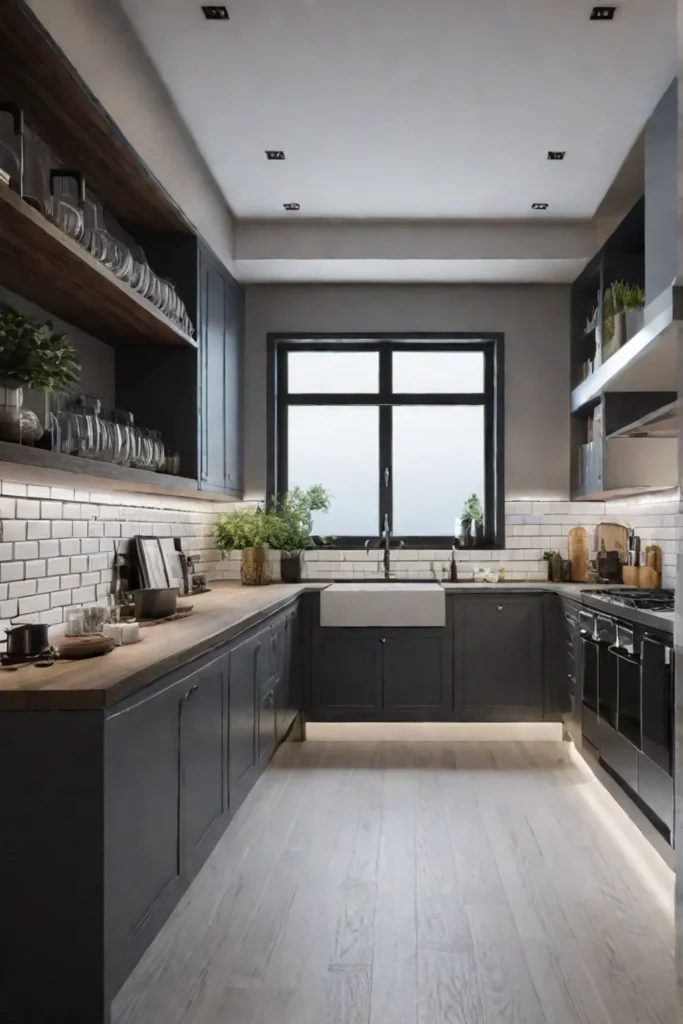
The Pros and Cons of Open Shelving
Let’s start with the good stuff. Open shelving is like giving your kitchen a breath of fresh air. It creates visual space, making even the tiniest kitchen feel more open and airy. Plus, it’s a great way to show off your personality. Those quirky mugs from your travels or that vintage tea set from Grandma? They’re not just functional; they’re now part of your decor!
But, I’ll be honest with you – it’s not all sunshine and rainbows. Open shelves can be a dust magnet, and in a kitchen, that means more frequent cleaning. And let’s not forget about grease. If you’re a fan of stir-frying like I am, you might find yourself wiping down those shelves more often than you’d like.
Styling Open Shelves for Maximum Impact
Now, let’s talk about making those shelves look amazing:
- Mix and match: Combine open shelves with closed cabinets for a balanced look.
- Go for quality: Choose sturdy materials like solid wood or metal for durability.
- Think in layers: Place taller items at the back, medium in the middle, and smaller items in front.
- Color coordinate: Group items by color for a cohesive look.
- Add some green: A small potted herb or two can bring life to your shelves.
Keeping It Clean and Organized
I know what you’re thinking – “Craig, how do I keep this looking good?” Here are my tried-and-true tips:
- Use it or lose it: Only keep items you use regularly on open shelves.
- Invest in pretty storage: Decorative jars and baskets can hide less attractive items.
- Regular maintenance: A quick daily wipe-down prevents major buildup.
- Rotate items: Switch things up seasonally to keep your space feeling fresh.
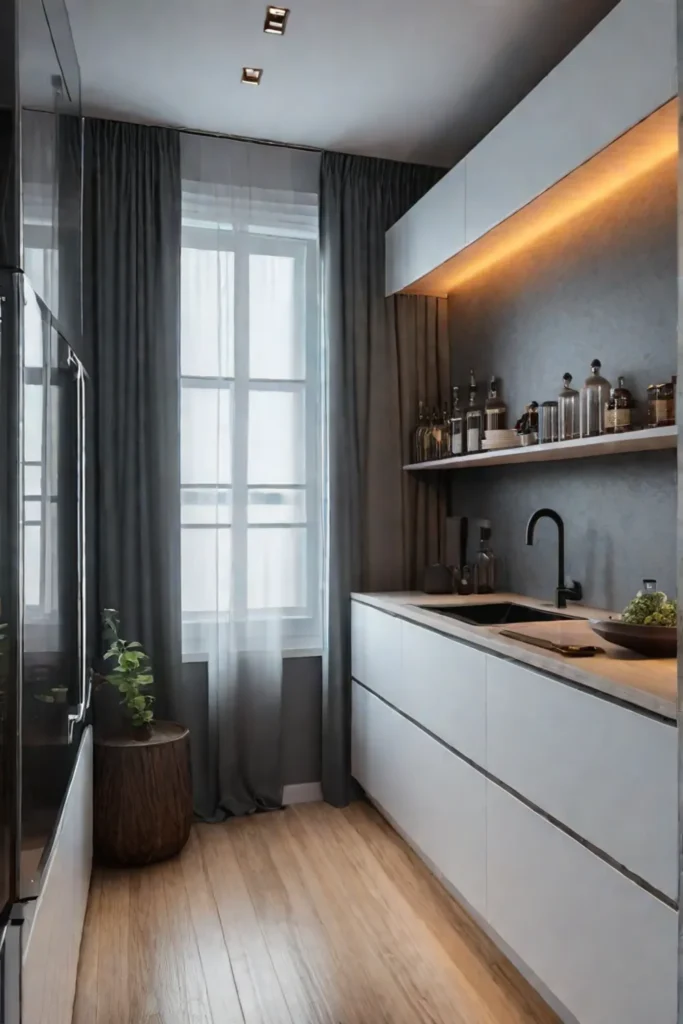
The Best Materials for Open Shelves
In my years of DIY, I’ve found that solid wood shelves are hard to beat. They’re durable, easy to clean, and age beautifully. But if you’re going for a more industrial look, don’t overlook metal shelving. It’s sturdy and can handle heavier items like cast iron cookware.
For a budget-friendly option, I’ve had great success with floating shelves made from reclaimed wood. It’s a sustainable choice that adds character and charm to your kitchen.
Open shelving isn’t just a trend; it’s a smart solution for small kitchens. It opens up your space, showcases your personality, and keeps everything within easy reach. Sure, it requires a bit more upkeep, but the payoff in style and functionality is worth it.
As we move on to our next topic, let’s shift our focus upward. In “Upward and Onward: Vertical Storage Solutions,” we’ll explore how to make the most of every inch of your kitchen, from floor to ceiling. Trust me, you’ll be amazed at how much space you have!
Upward and Onward: Vertical Storage Solutions
It’s time to talk about one of my favorite small kitchen hacks: going vertical! As a born-and-bred Atlanta boy who’s seen his fair share of cozy kitchens, I can tell you that the secret to maximizing space is often right above your head.
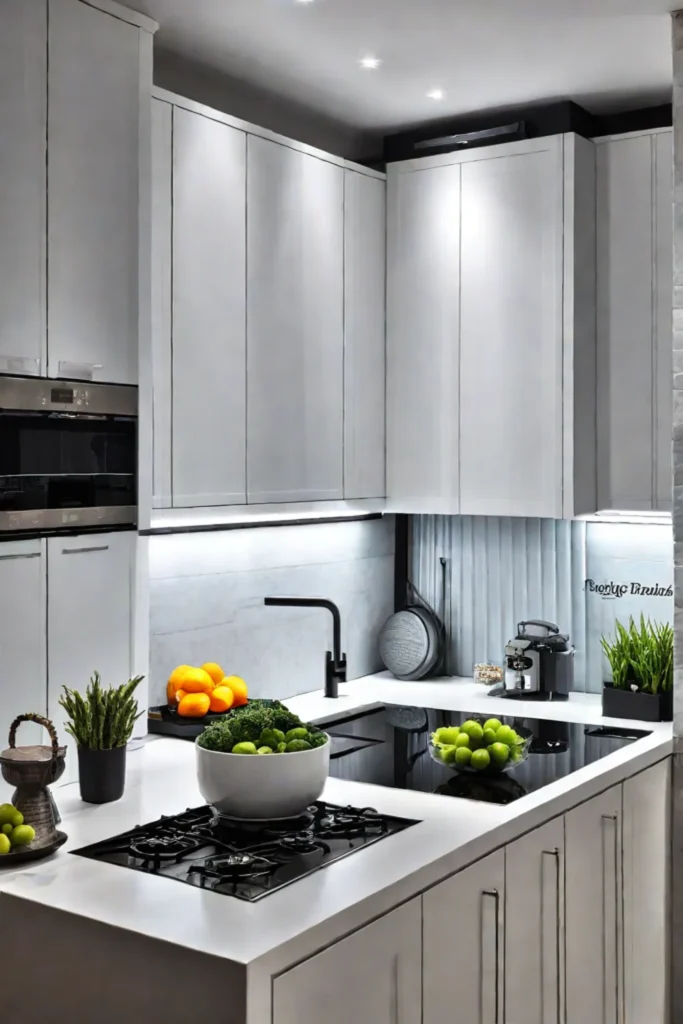
Reach for the Sky: Innovative Vertical Storage Ideas
Listen, I’ve been in kitchens where you couldn’t swing a cat without knocking over a spice rack. But here’s the kicker: most of these spaces had more unused vertical real estate than downtown Atlanta! Here are some game-changing ideas to help you make the most of every inch:
- Floor-to-ceiling cabinets: These bad boys can double your storage capacity. I once installed these in a client’s galley kitchen, and it was like we’d added a whole new room!
- Wall-mounted racks: Perfect for pots, pans, and utensils. They’re like floating organizers that free up your counters and drawers.
- Hanging baskets: Great for fruits, veggies, or even your dish towels. Plus, they add a touch of rustic charm.
- Magnetic knife strips: Say goodbye to that bulky knife block eating up your counter space.
Choosing the Right Vertical Storage for Your Needs
Now, before you go wild and start drilling holes in every wall, let’s talk strategy. Here’s how to pick the perfect vertical storage solutions:
- Assess your needs: What are you struggling to store? Pots and pans? Spices? Snacks?
- Consider your kitchen’s style: A sleek, modern kitchen might benefit from floating shelves, while a farmhouse-style space could rock some vintage-inspired hanging baskets.
- Think about accessibility: Make sure frequently used items are within easy reach.
- Don’t forget safety: When installing vertical storage, always check weight limits and use proper anchors. Trust me, you don’t want your beautiful new pot rack crashing down mid-spaghetti night!
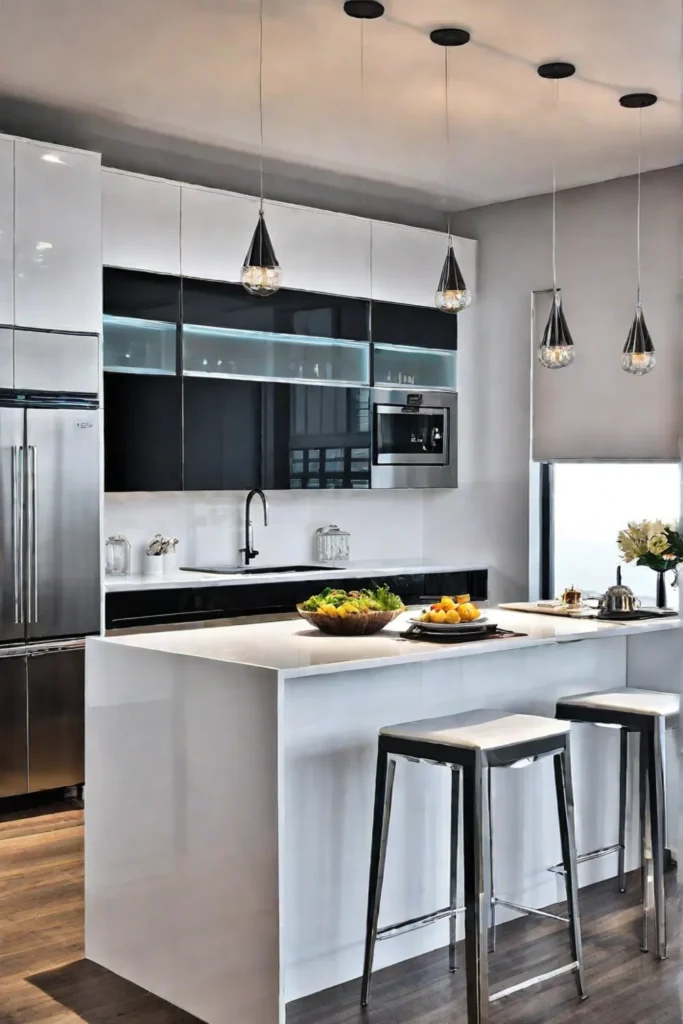
Pro Tips from a DIY Devotee
- Install tall cabinets that extend to the ceiling. That awkward space above standard cabinets? It’s prime real estate for those once-a-year items like your turkey roaster or grandma’s punch bowl.
- Use wall-mounted spice racks. I’ve seen these turn chaotic drawers into organized flavor stations.
- Hang a ceiling pot rack. It’s not just storage; it’s a statement piece that screams “seasoned chef at work!”
Here’s a little-known fact: the average kitchen has about 20% unused vertical space. That’s like having an extra cabinet hiding in plain sight!
When it comes to popular vertical storage solutions, wall-mounted shelves and over-the-door organizers are topping the charts. They’re easy to install (even for DIY newbies) and can hold a surprising amount of weight when properly secured.
Remember, folks, the key to maximizing a small kitchen is thinking outside the box – or in this case, above it. By utilizing your vertical space, you’re not just organizing; you’re creating a more functional and visually appealing kitchen that would make any Atlanta home decorator proud.
As we wrap up our vertical voyage, let’s shift gears and talk about another space-saving superstar. In our next section, “Multifunctional Marvels: Furniture That Works Overtime,” we’ll explore how to make every piece in your kitchen pull double duty. Trust me, y’all, after this, you’ll never look at a kitchen island the same way again!
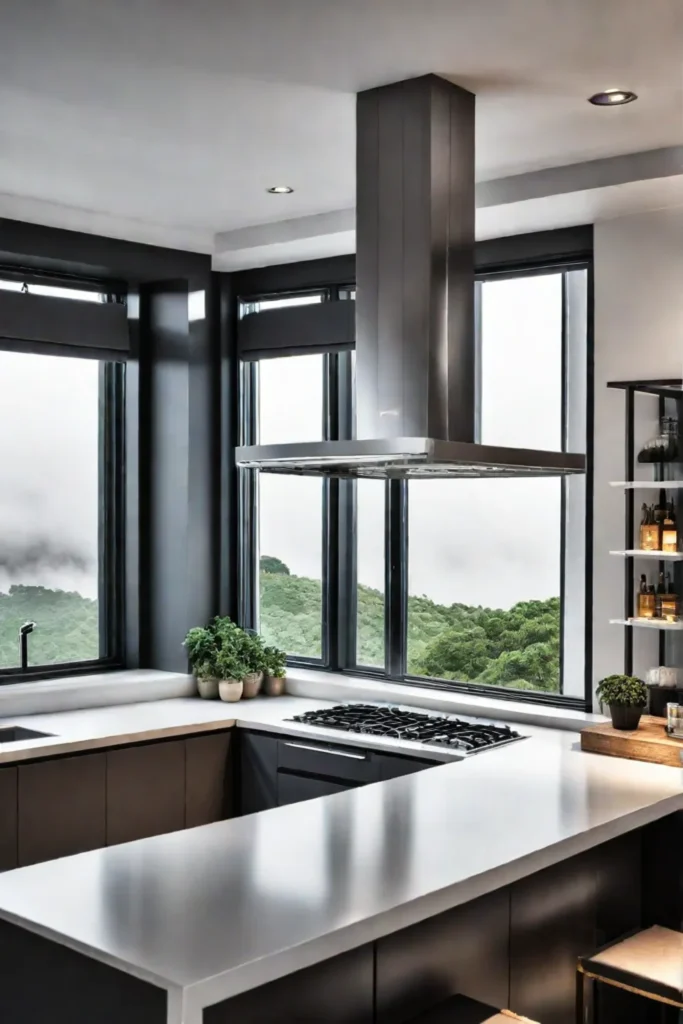
Multifunctional Marvels: Furniture That Works Overtime
Now we will dive into another of my favorite topics: furniture that pulls double (or even triple) duty in small kitchens. As someone who’s had to get creative in tight spaces, I can’t stress enough how game-changing multifunctional pieces can be. Let’s explore some smart solutions that’ll have your kitchen working harder than a coffee maker on Monday morning!
Space-Saving Furniture Ideas for Small Kitchens
- Kitchen Islands with Superpowers: I once helped a client transform her cramped kitchen into a nifty island that included built-in storage, a pull-out cutting board, and bar-style seating. It became the heart of her kitchen, serving as a prep station, dining area, and storage solution all in one!
- Drop-Leaf Tables: These are like the chameleons of the furniture world. I love recommending drop-leaf tables because they can expand for dinner parties and shrink back down when you need more floor space. It’s like magic, but better – because you get to eat at it!
- Nesting Stools: These little wonders can tuck away under your counter or table when not in use. I’ve seen sets that stack so neatly, that you’d think they were playing hide-and-seek with your kitchen space.
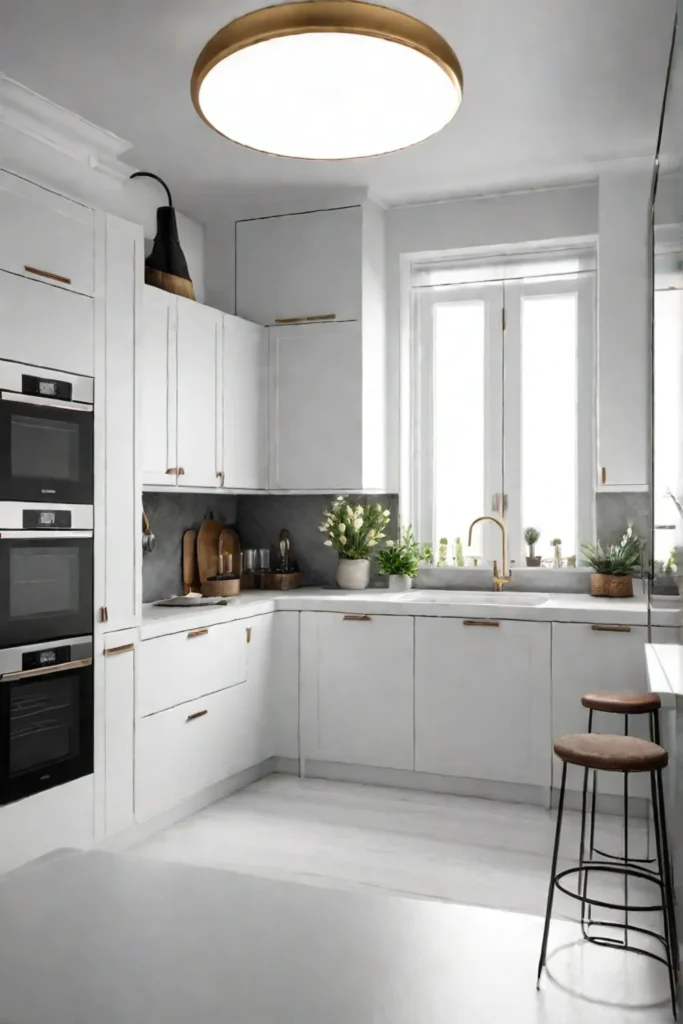
Choosing the Right Multifunctional Pieces
When picking out multifunctional furniture, consider these tips:
- Measure, measure, measure: Trust me, nothing’s worse than finding the perfect piece only to realize it doesn’t fit through the door. Been there, done that, got the bruised ego to prove it.
- Quality matters: Since these pieces will be working overtime, invest in sturdy, well-made furniture that can handle the wear and tear.
- Style sync: Make sure your multifunctional pieces match your kitchen’s overall vibe. Just because it’s practical doesn’t mean it can’t be pretty!
Latest Trends in Multifunctional Kitchen Furniture
The multifunctional furniture game is constantly evolving, and I’m loving some of the latest trends:
- Smart storage solutions: Think cabinets with built-in charging stations for your devices or drawers with customizable compartments.
- Convertible countertops: Some genius designers have created countertops that can transform into tables or even hide appliances underneath.
- Eco-friendly materials: Many brands are now offering multifunctional pieces made from sustainable materials, perfect for those of us trying to keep our carbon footprint as small as our kitchens.
Brands to Watch
While I can’t endorse specific brands, keep an eye out for companies that specialize in small-space solutions. Many Scandinavian design firms are ahead of the curve on this, and some great online retailers are focusing exclusively on multifunctional furniture for compact living.
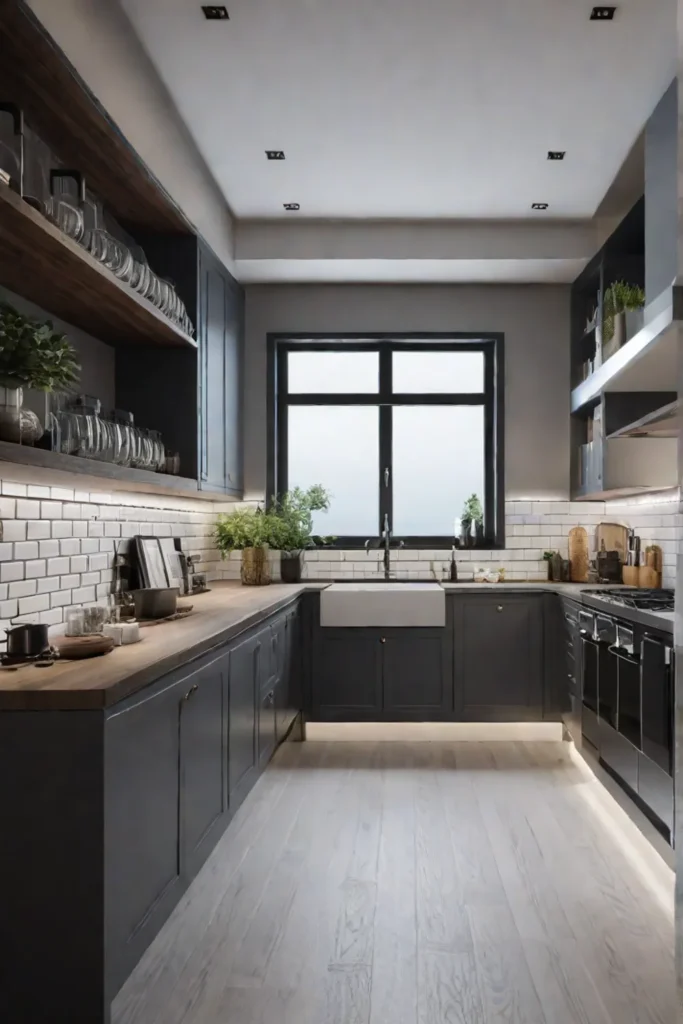
Remember, folks, in a small kitchen, every inch counts. By choosing furniture that works overtime, you’re not just saving space – you’re creating a more efficient, enjoyable cooking and living area. It’s all about working smarter, not harder!
As we wrap up our discussion on multifunctional marvels, let’s shift gears and talk about another crucial aspect of maximizing your small kitchen: decluttering. Because sometimes, the best way to make the most of your space is by having less in it. Stay tuned as we explore how less can truly be more in a small space!
Decluttering: Less is More in a Small Space
Alright, folks, let’s talk about the elephant in the room – or should I say, the clutter in your kitchen? As someone who’s seen his fair share of cramped cooking spaces, I can tell you that nothing makes a small kitchen feel more claustrophobic than unnecessary stuff lying around. So, let’s roll up our sleeves and get down to business!
The Great Kitchen Purge
First things first, it’s time for some tough love with your kitchen gadgets. I know, I know – that avocado slicer seemed like a great idea at the time, but when was the last time you used it? Here’s a quick tip: spread out all your kitchen tools on the counter and ask yourself, “Have I used this in the last six months?” If the answer’s no, it might be time to say goodbye.
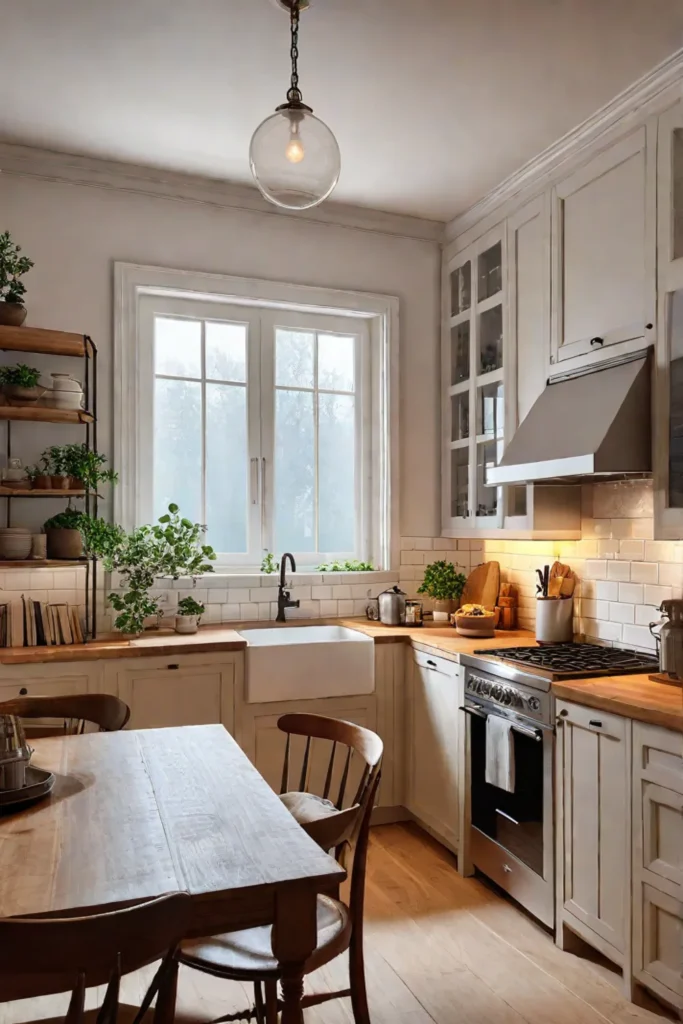
Remember, folks, studies have shown that clutter can increase stress and anxiety levels. So by decluttering, you’re not just making your kitchen look better – you’re doing your mental health a favor too!
Smart Storage Solutions
Now that we’ve trimmed the fat, let’s talk about organizing what’s left. Here are some of my favorite tricks:
- Drawer dividers: These babies are a game-changer for utensil drawers.
- Shelf risers: Double your cabinet space in seconds.
- Magnetic knife strips: Free up counter space and add a cool, industrial vibe.
- Over-the-door organizers: Perfect for spices or cleaning supplies.
Pro tip: Store those once-a-year items (like your turkey baster or fancy serving platters) in a separate area. No need to have them hogging prime real estate in your everyday cooking space!
The KonMari Method Meets the Kitchen
For those of you who’ve been living under a rock (or a pile of clutter), Marie Kondo’s famous organizing method can work wonders in the kitchen. The basic idea? Only keep items that “spark joy.” In kitchen terms, that means keeping tools that make your cooking life easier and more enjoyable.

I once helped a client in Atlanta declutter her tiny galley kitchen using this method. We ended up donating three boxes of unused gadgets and found space for a small herb garden by the window. Talk about a win-win!
Professional Help: It’s Not Just for Your Head!
If you’re feeling overwhelmed, don’t worry – there are pros out there who specialize in small kitchen organizations. The National Association of Productivity & Organizing Professionals (NAPO) has a directory where you can find organizers in your area. Some even specialize in kitchens!
Remember, folks, a clutter-free kitchen isn’t just about looks – it’s about creating a space where you want to cook and spend time. And in a small kitchen, every inch counts!
As we wrap up our decluttering journey, let’s turn our attention to another crucial aspect of making your small kitchen feel bigger and brighter. In our next section, “Let There Be Light: Strategic Lighting Solutions,” we’ll explore how the right illumination can transform your space from cramped to cozy. Trust me, you won’t want to miss these enlightening tips!
Let There Be Light: Strategic Lighting Solutions
After seeing my fair share of dimly lit culinary spaces, let me tell you, the right lighting can work wonders. So, let’s shed some light on how to brighten up your compact cooking haven!
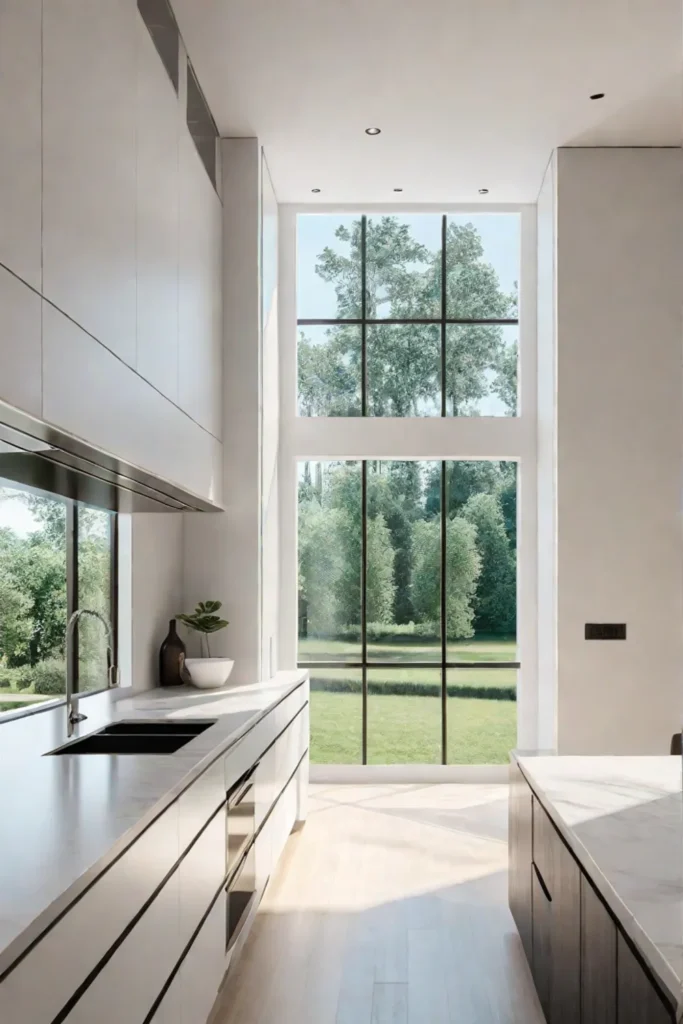
Types of Kitchen Lighting
In my years of transforming Atlanta homes, I’ve learned that a well-lit kitchen is all about layering. Here’s the lowdown on the types of lighting you’ll want to consider:
- Natural light: Mother Nature’s gift to us all. If you’ve got a window, flaunt it!
- Ambient lighting: This is your overall room illumination.
- Task lighting: Focused light for chopping, reading recipes, and other kitchen tasks.
- Accent lighting: The cherry on top that adds depth and highlights your favorite features.
Creating a Layered Lighting Scheme
Now, let’s talk strategy. Here’s how to combine these lighting types for maximum impact:
- Maximize natural light: Ditch those heavy curtains, folks! Opt for sheer window coverings or, better yet, leave those windows bare. I once helped a client in Midtown who swapped their dark blinds for a simple Roman shade, and boom! Instant kitchen facelift.
- Install under-cabinet lighting: This is a game-changer for task lighting. LED strips are my go-to – they’re energy-efficient and cast a clean, even light on your work surface. Plus, they’re a breeze to install, even for DIY newbies.
- Go for a statement centerpiece: Nothing says “welcome to my kitchen” like a stunning pendant light or chandelier. It’s not just about illumination; it’s about creating a focal point. I recently installed a rustic industrial pendant in a Buckhead loft kitchen, and it transformed the space.
- Don’t forget the corners: Recessed lighting in the ceiling corners can eliminate shadows and make your kitchen feel larger. It’s like magic!
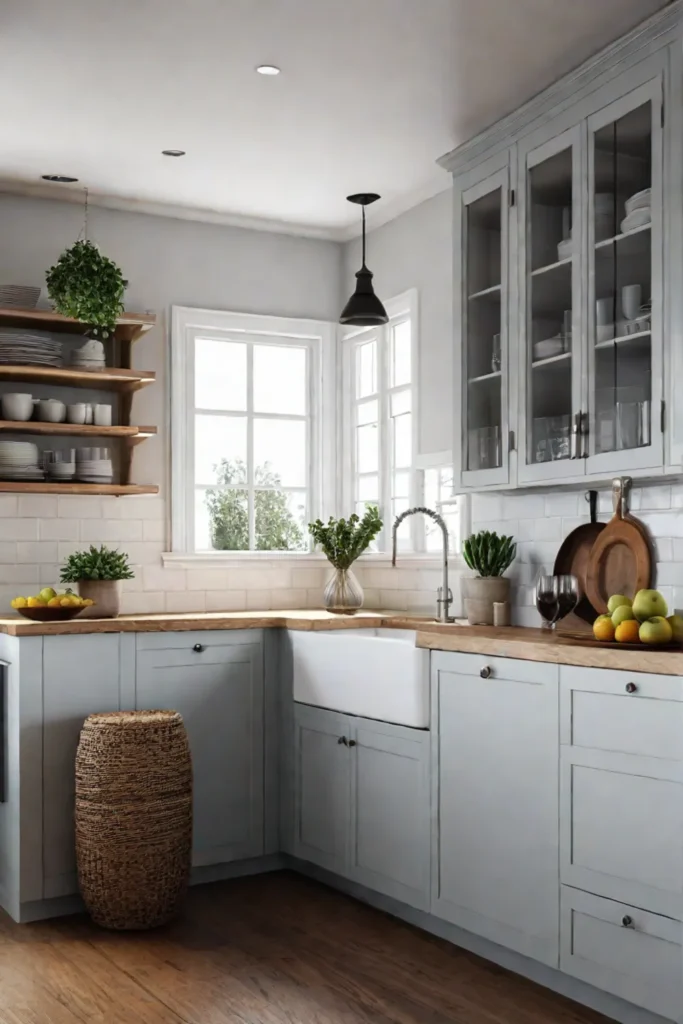
Now, I know what you’re thinking – “Craig, what about the latest trends?” Well, my friends, the hottest thing in kitchen lighting right now is smart lighting. Imagine adjusting your kitchen lights with a voice command or your smartphone. It’s not just cool; it’s practical for those moments when your hands are covered in cookie dough!
Speaking of practicality, let’s talk about energy efficiency. LED lights are your best bet for a small kitchen. They’re long-lasting, use less energy, and don’t heat the space (which is crucial when you’re working in close quarters). Plus, they come in a variety of color temperatures, so you can choose between a warm, cozy glow or a crisp, clean light.
Remember, the key to great kitchen lighting is flexibility. You want to be able to create the right ambiance for every situation, whether you’re prepping a gourmet meal or enjoying a late-night snack.
As we wrap up our lighting adventure, let’s not forget that less can sometimes be more. In our next section, “Minimalism: A Breath of Fresh Air,” we’ll explore how embracing a clutter-free aesthetic can make your small kitchen feel spacious and serene. Get ready to declutter and breathe easy!
Minimalism: A Breath of Fresh Air
There’s nothing quite like the relief of walking into a clean, streamlined kitchen. It’s like taking a deep breath after holding it in for too long. So, let’s dive into how we can make your small kitchen feel like a zen oasis.
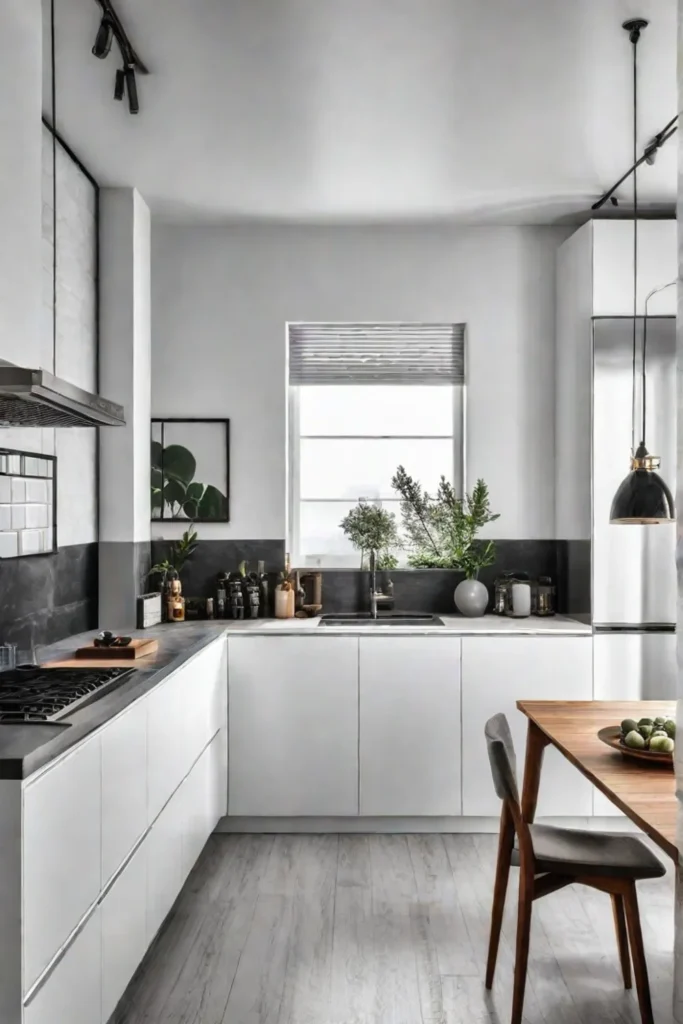
The Principles of Minimalist Design
Minimalism isn’t just about throwing everything away (though I won’t lie, sometimes that’s tempting). It’s about embracing simplicity and functionality. Think clean lines, uncluttered surfaces, and a “less is more” approach. In my years of renovating kitchens across Atlanta, I’ve found that minimalism can turn even the tiniest galley kitchen into a space that feels open and inviting.
Here are the key principles:
- Focus on functionality
- Embrace negative space
- Use a limited color palette
- Choose quality over quantity
Applying Minimalism to Your Kitchen
Now, I know what you’re thinking: “Craig, my kitchen is already small. How can I make it more minimal?” Well, my friends, it’s all about smart choices and a little bit of tough love with your stuff.
- Declutter Like You Mean It: Be ruthless. If you haven’t used that avocado slicer in a year, it’s time to say goodbye.
- Sleek and Chic: Choose appliances and furniture with clean, simple lines. That retro toaster might be cute, but a sleek stainless steel one will give you that minimalist vibe.
- Clear the Decks: Keep your countertops as clear as possible. Trust me, it’ll make your kitchen feel twice as big.
- Color Me Calm: Stick to a palette of 2-3 colors. I’m a big fan of white with wood accents – it’s clean, it’s classic, and it never goes out of style.
- Hidden Storage: Invest in smart storage solutions that keep things out of sight. Pull-out pantries and under-cabinet organizers are your new best friends.
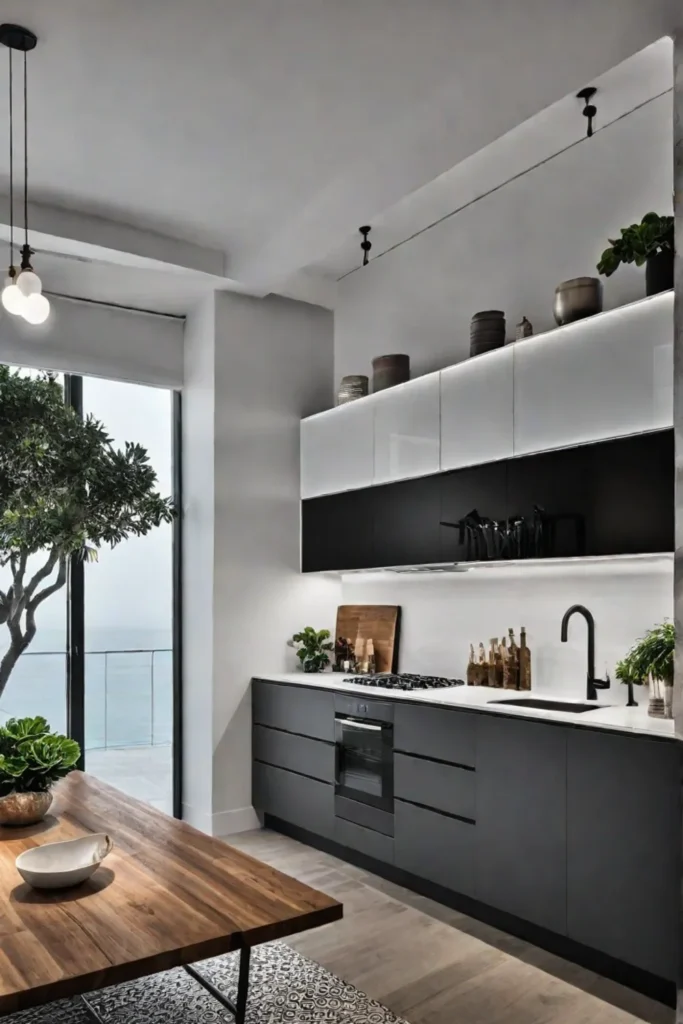
Brands That Get It
Now, I’m not one for pushing brands, but if you’re looking for some minimalist inspiration, check out IKEA’s VOXTORP line or Muji’s kitchen accessories. They’ve got that minimalist aesthetic down to a science.
Making the Transition
“But Craig,” I hear you ask, “how do I incorporate this into my existing kitchen?” Well, start small. Clear off one countertop and see how it feels. Replace one cluttered shelf with a clean, minimalist one. It’s like dipping your toe in the water before diving in.
Remember, minimalism isn’t about deprivation – it’s about creating space for what matters. In a small kitchen, that means more room to cook, entertain, and enjoy your space.
As we wrap up our minimalist makeover, let’s not forget that a clutter-free kitchen is just the beginning. In our next section, we’ll be tying all these ideas together and seeing how they can transform your small kitchen into a space that’s not just functional, but downright fabulous. So stick around, because the best is yet to come in our conclusion!
Conclusion
Well, folks, we’ve covered a lot of ground today – from light and mirrors to vertical storage and minimalism. But remember, the key to a fabulous small kitchen isn’t just about following trends or buying fancy gadgets. It’s about creating a space that works for you, reflects your personality, and makes you want to whip up some Southern comfort food (or at least order takeout in style).
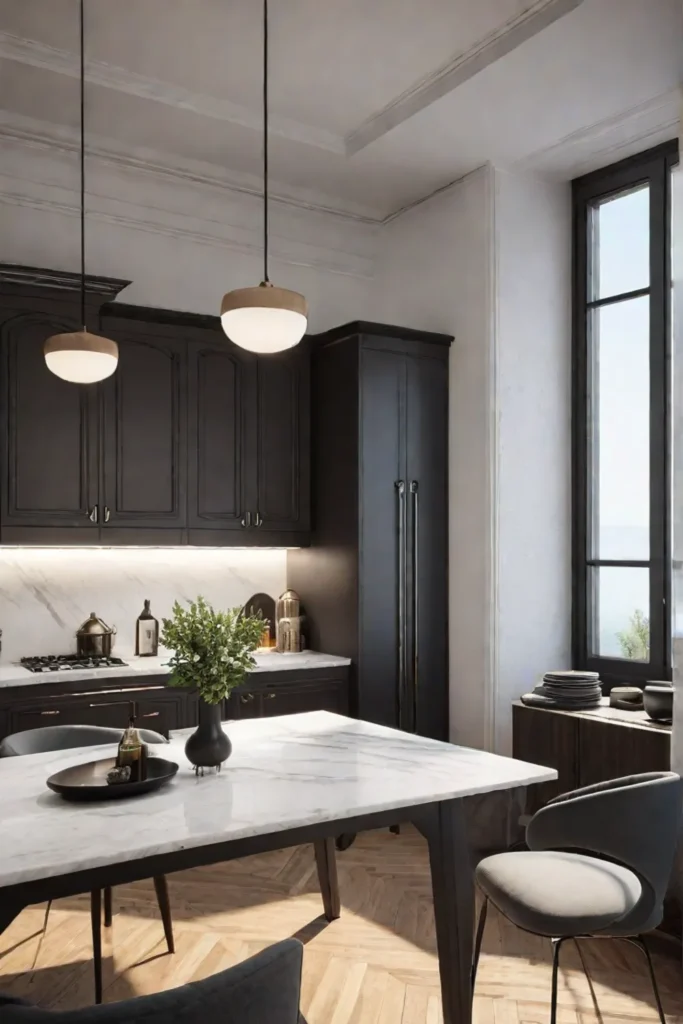
As we wrap up, I want you to take a moment and imagine your ideal kitchen. Maybe it’s bright and airy, with open shelves displaying your grandmother’s china. Or perhaps it’s a sleek, minimalist haven with hidden storage for days. Whatever your vision, I hope these tips have inspired you to see the potential in your small space. Remember, a kitchen isn’t just a room – it’s the heart of your home. So go on, give it some love, and watch it shine brighter than a Georgia summer day. And hey, if you need any more advice, you know where to find me – probably elbows deep in my next DIY project!
